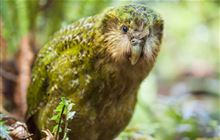Bumper breeding season boosts Kākāpō population
Archived content: This media release was accurate on the date of publication.
Introduction
Kākāpō numbers have increased from 197 to 252 in the 2022 breeding season, and there are now more of the endangered parrots than there have been for almost 50 years.Date: 09 August 2022 Source: Office of the Minister of Conservation
The flightless, nocturnal parrot is a taonga of Ngāi Tahu and a species unique to New Zealand. They breed only every two to four years when rimu trees produce enough fruit.
During breeding seasons, the Department of Conservation (DOC) and Ngāi Tahu aim to have as many kākāpō chicks raised in nests as possible. They only intervene with hand-rearing when chicks are at risk. This season 49 were raised in the nest and six were fully hand reared.
“There is an all-hands-on-deck approach to saving kākāpō,” says Conservation Minister Poto Williams. “This has been the second biggest breeding season, leading to the highest number of birds since the 1970s, but we can’t take our eye off the ball.
“The season’s 55 kākāpō chicks were added to the official population only when they reached 150 days old. The chicks generally get themselves in to high risk situations, and occasionally need to be rescued from clumsy episodes, such as getting stuck in mud or getting their legs caught in trees.”
This season the team had unprecedented success in its artificial insemination project. Kākāpō have very low fertility (only 77 of this year’s 141 eggs were fertile), and some male kākāpō produce few or no offspring, which worsens the already limited genetic diversity of the species.
“Between 2009 and 2019, with the help of international experts, five chicks were produced by artificial insemination. Due to COVID-19 border closures, the team tackled the project alone in 2022 and produced a record-breaking nine chicks. Eight of these chicks are still alive, ensuring precious genetics are maintained in the population.
“The 2022 season also saw three of the chicks hatched at a new breeding site – Te Kākahu-o-tamatea/Chalky Island. These chicks were monitored using a new, hands-off method. An International Visitor Levy-funded 'Kākāpō Expansion Project' is helping the team develop new tools and strategies for more remote monitoring, as they aim to manage more kākāpō with less intensive methods, at more sites.
“DOC’s Kākāpō Recovery Team includes technical specialists, volunteers and field rangers, who work hard to ensure as many fledglings make it through this awkward phase as possible, with support from Dunedin Wildlife Hospital and Auckland Zoo teams, should any chicks be found in trouble.”
Tāne Davis has been Te Runanga O Ngāi Tahu representative for the Kākāpō Recovery Programme since 2005, helping guide policy decisions concerning the protection, management and conservation of kākāpō. He says the Ngāi Tahu takiwā is where the last surviving kākāpō were found.
“Ngāi Tahu connections to the mauri of kākāpō is strengthened as the population grows. Our vision for kākāpō is to grow their numbers and ensure they can live freely in a natural environment.
"Ngāi Tahu recognises and supports Rakiura becoming pest free, then kākāpō can be returned to their original kāinga. The success of the 2022 kākāpō breeding season can be commended to the close working partnerships within the Kākāpō Recovery Team and Ngāi Tahu.”
Acknowledging the world-wide interest in kākāpō, DOC has worked with Urban Wildlife Trust and ICONA to live-stream camera footage from a kākāpō nest. They hope to have it running in time for the next breeding season. This will allow kākāpō enthusiasts around the world to watch the chicks hatch and follow their progress until they leave the nest.
Contact
For media enquiries contact:
Email: media@doc.govt.nz

